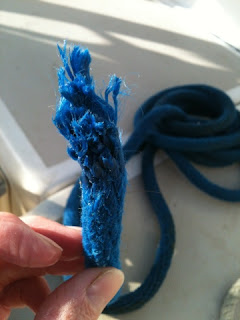According
to The
New York Times, creating fake news--i.e., lying--has become de rigueur. It is pervasive, and,
apparently, accepted by a large percentage of the population.
Naturally,
I want to conform to societal norms and be one of the crowd. I guess
that means being disingenuous in making promises, coming
up with some totally fabricated name-dropping to throw out at
cocktail parties, and otherwise making up stories that make me look
good and blame my troubles on somebody else. So here goes: totally fabricated stories about what could have
happened during the last few days of our 2016 cruise on the
Intracoastal Waterway (ICW). Leaving you to ponder: truth or fiction?
We
entered Georgia waters expecting to be coddled with good ol' southern hospitality. Instead, we were instantly challenged to find
any water deep enough for a boat. The Georgia legislature, it seems,
is broke and politically in shreds. No one is willing to vote for
expensive projects such as dredging and charting waterways and
harbors.
As
the number on our depth sounder (which measures feet of water under
our boat) dropped down, down, down, I uncharacteristically lost my
composure. When it reached 0.6, I descended into full-fledged hysterics, leaving Pope to
cope with bumping the boat along through sandbars and mud flats.
By
some miracle, we avoided running aground. We crossed the
broad (and deep) Savannah River that flows to the Atlantic, hopping and skipping out of the way of large freighters that barely missed us by inches. Since they travel at 10 times the speed
we do, and are roughly 1,000 times as large, steering quickly out of
the way of a small sailboat is not their strong point.
The
next thing we knew, a northbound sailboat came veering toward our bow, its skipper frantically shouting above the wind: “Bridge
closed! Turn around!'
Swing
bridges and draw bridges are common on the ICW; in fact, there are
roughly five or six dozen erected across the waterway just to vex cruisers like us. At each bridge, we have to call the operator on our VHF radio, then wait, and wait, and wait, for traffic to
be stopped and the center of the bridge opened, while motoring in circles, often in strong wind and current. At the one shown below, for
example, we waited roughly 30 minutes. Multiply by 75, and you can
see why a cruise on the ICW is a long, slow burn.
We
confirmed that the swing bridge in question, just south of Savannah, was closed indefinitely, apparently awaiting the heavily touted federal funds
promised by President-elect Trump for repairing our nation's
infrastructure. In fact, since he announced his plan to fix our roads
and bridges, we've noticed a distinct increase in lengthy closures.
To
add to this latest effrontery, Trump threw yet another curve ball at
us—probably to make sure that those of us who didn't vote for him
wouldn't be able to enjoy ourselves in the Bahamas while he had to go
to work in the White House. He closed the ICW farther south in
Florida, so he and his business cronies could throw a waterside pool party for
all of their trophy wives to get a golden tan.
With
the sun dropping and the air turning chilly, we needed a
place to park the boat, since our proposed anchorage was beyond the inoperable bridge. We were stuck in the Savannah River, with no
marinas or anchorages in sight.
As
the situation turned desperate, we headed 12 miles up the Savannah River to
the industrial port of Savannah—a hellish place to park a
pleasure boat.

All but one dock open to pleasure boats had been destroyed by the hurricane. Fresh out of options, sun sinking in the west, we paid a shady-looking attendant $100 to
use that lone dock for a few hours of sleep.
But! No rest for the weary in Savannah--oh no! All night long, ocean liners hauling millions of tons of freight pushed millions of
gallons of water in their wake, rocking our boat like a child jumping up and down on a hobbyhorse.
The freighters bore down without mercy—closer, closer, their stacks of containers towering above and threatening
to crush us to smithereens.
Each
time a ship safely passed, I breathed a huge sigh of relief. But Georgia was not finished with us yet. Huge logs, boards with nails
protruding, and even whole trees torn from their roots by the hurricane thumped,
thumped, thumped against our hull. Sewage poured out of pipes in the
seawall onto the side of our boat.
The
stress on our lines was unbearable. In the middle of the night, one of our lines ripped
cleanly in half. Now I understood the lament of boaters up and down the ICW whose 1/2-inch to 3/4-inch lines had snapped during Hurricane Matthew, leaving their investments in the weeds--literally. Fortunately, I had talked Pope into doubling up our lines that night in Savannah!
As
soon as dawn glowed in the east, after only two or three hours of
restless sleep, we hightailed it out of Savannah and turned around,
heading north, back up the ICW. We didn't stop until we re-crossed
the border. We anchored that night in a quiet, calm creek in South
Carolina, with plenty of water under our keel.
Nothing
has ever been as welcome as what we saw the next morning: waves of golden marsh grass lining the banks, beckoning us to enjoy the tranquil scenery on the journey to our next destination: Washington, DC, and home.












No comments:
Post a Comment